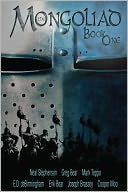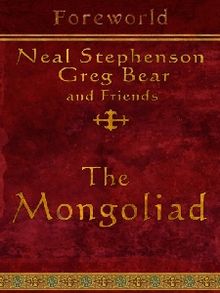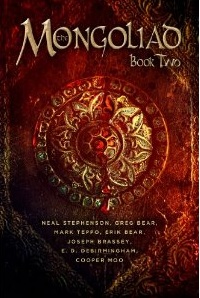 The Mongoliad, of which Book One has just been published, is any number of things. It’s the first book in something its seven creators call The Foreworld Saga–more on that later. It’s also a cooperative effort with seven, count them, seven authors–but it isn’t a collection of short stories. It’s a novel, at least as published.
The Mongoliad, of which Book One has just been published, is any number of things. It’s the first book in something its seven creators call The Foreworld Saga–more on that later. It’s also a cooperative effort with seven, count them, seven authors–but it isn’t a collection of short stories. It’s a novel, at least as published.
It started out as an experiment. A serial novel, published online at mongoliad.com, then the result edited down and published as a novel.
About that serial story, and the origins of the novel, and the effect it has on the book that I read. In other words, why did I go hunting for the website?
The Mongoliad, Book One, felt like it dropped me into the middle of the story. Or two stories.
The book takes place in 1241. In history, that was when Ögedei Khan, son of the famous Genghis Khan, controlled most of Asia, and had stretched his vast empire into Eastern Europe.
Not part of history was the “Circus of Swords” that draws the great Western champions to Legnica in Western Poland. There was a battle there during the Mongol invasion of Europe. But not a tournament.
 The authors of The Mongoliad invented the tournament as part of their alternate history, The Foreworld Saga. They wanted to create a story-vehicle for fighters of as many different schools of Western Martial Arts as possible to get a chance to use those arts. (This idea isn’t new, Tolkien initially wrote the Lord of the Rings because he invented Elvish first and wanted to create a world where it was spoken)
The authors of The Mongoliad invented the tournament as part of their alternate history, The Foreworld Saga. They wanted to create a story-vehicle for fighters of as many different schools of Western Martial Arts as possible to get a chance to use those arts. (This idea isn’t new, Tolkien initially wrote the Lord of the Rings because he invented Elvish first and wanted to create a world where it was spoken)
So, we have the “Circus of Swords”. We have a group of champion fighters. What’s the story? The tournament is not the story.
One part of the story turns out to be leaving the tournament on a quest to assassinate the Great Khan and save Western Europe from invasion.
The second part of the story takes place at the Great Khan (Ögedei’s) court. One of Ogedei’s brothers sends a young warrior, Gansukh, to court to try to convince the Khan not to drink quite so much. (According to Wikipedia, Ögedei Khan did actually drink prodigiously)
Gansukh is assigned a tutor to learn to navigate the dangerous ways of the court, because he is more used to killing his enemies with his sword than being flayed with sharp tongues. And in order to have any influence with the Khan, he will need to find a way to get close to the Khan without murdering his favorites.
So there are two stories, the Western champions working their way towards the Mongol capitol, Karakorum, in order to assassinate the Khan, and Gansukh, trying to find a way to save the Khan from his own alcoholism, and the resultant loss of respect. Also, Gansukh has to keep himself alive among the snakes at court.
 These two stories are going to intersect, but not until at least Book Two!
These two stories are going to intersect, but not until at least Book Two!
Escape Rating C: It took half the book for the story to truly capture my interest. And half this book is 200 pages. If I hadn’t been assigned this for a magazine review, I might not have finished.
Gansukh’s story is the more coherent. His is a distinctive personality, and his point of view is easy to follow. Also, the “fish out of water” position he finds himself in is one that is easy to sympathize with. He wants to be back on the steppes, and the reader understands completely!
The Western champions are much harder to distinguish. There are too many, and they don’t talk a lot. A lot of men who are primarily interested in fighting don’t discuss their feelings or motivations a whole lot, which makes it hard to empathize. Everyone is mysterious. The point of view character is Cnán, a girl from a group known as the Binders — whose origins and motivations the reader also doesn’t know.
And is this alternate history, fantasy, or something else? The information at mongoliad.com leads one to the conclusion that it is sort of alternate history, but not yet. A cliffhanger ending is one thing, but this much outright obscurity does not inspire me to continue.
